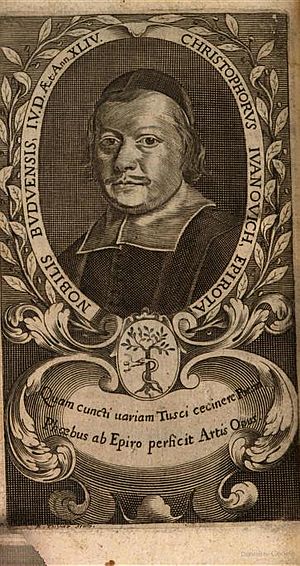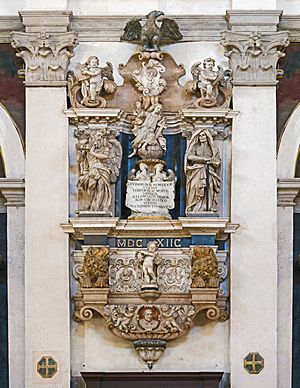Cristoforo Ivanovich facts for kids
Cristoforo Ivanovich (1628-1689) was a poet and writer from Montenegro. He lived in the Republic of Venice and wrote all his works in Italian. He is famous for writing the first "History of Theater," which looked at the history of opera in Venice.
Life of Cristoforo Ivanovich
Cristoforo Ivanovich was born in Budua (which is now in Montenegro) in 1628. He came from an old family in Dalmatia.
He loved poetry from a young age and started writing when he was a teenager. When he was 25, he moved to Italy. There, he became a successful writer and scientist. He was especially known for writing libretti, which are the stories or words for operas.
In 1655, he moved to Verona. He joined two important groups there: the "Accademia Filarmonica" and the "Accademia dei Temperati." These were groups for people interested in music and learning.
In 1657, Ivanovich moved to Venice. He lived there until he passed away in 1688. From 1663, he wrote many works for operas. These operas were performed in theaters in Venice, Vienna, and Piacenza. In his later years, he wrote his most famous book, Le memorie teatrali di Venezia.
Works of Cristoforo Ivanovich
Cristoforo Ivanovich wrote many opera librettos, all in Italian. Some of his main works include:
- L'amor guerriero
- La Circe
- Coriolano
- La costanza trionfante
- Lisimaco
- L'africano trionfo di Pompeo
- La felicità regnante
- Minerva al tavolino
In the first part of his career, Ivanovich focused on works that celebrated important events. For example, he wrote L'amor guerriero in 1663. This opera was later set to music as La Circe and performed for the birthday of Emperor Leopold I. He also wrote Il Coriolano in 1669.
Later, he wrote more for the general opera audience in Venice. He changed some existing works, like "Ipermestra," to create "La costanza trionfante" for the Venetian public. He also updated his own opera, "Circe," in 1679.
In 1681, he wrote what many consider his most important work: Le memorie teatrali di Venezia. In this book, he wanted to record the history of theater and drama in Venice. It contains valuable information about how theaters worked and the shows performed in the city during his time.
Related pages
See also
 In Spanish: Cristoforo Ivanovich para niños
In Spanish: Cristoforo Ivanovich para niños



